Haoyu Cao
VITA-VLA: Efficiently Teaching Vision-Language Models to Act via Action Expert Distillation
Oct 10, 2025Abstract:Vision-Language Action (VLA) models significantly advance robotic manipulation by leveraging the strong perception capabilities of pretrained vision-language models (VLMs). By integrating action modules into these pretrained models, VLA methods exhibit improved generalization. However, training them from scratch is costly. In this work, we propose a simple yet effective distillation-based framework that equips VLMs with action-execution capability by transferring knowledge from pretrained small action models. Our architecture retains the original VLM structure, adding only an action token and a state encoder to incorporate physical inputs. To distill action knowledge, we adopt a two-stage training strategy. First, we perform lightweight alignment by mapping VLM hidden states into the action space of the small action model, enabling effective reuse of its pretrained action decoder and avoiding expensive pretraining. Second, we selectively fine-tune the language model, state encoder, and action modules, enabling the system to integrate multimodal inputs with precise action generation. Specifically, the action token provides the VLM with a direct handle for predicting future actions, while the state encoder allows the model to incorporate robot dynamics not captured by vision alone. This design yields substantial efficiency gains over training large VLA models from scratch. Compared with previous state-of-the-art methods, our method achieves 97.3% average success rate on LIBERO (11.8% improvement) and 93.5% on LIBERO-LONG (24.5% improvement). In real-world experiments across five manipulation tasks, our method consistently outperforms the teacher model, achieving 82.0% success rate (17% improvement), which demonstrate that action distillation effectively enables VLMs to generate precise actions while substantially reducing training costs.
CROP: Integrating Topological and Spatial Structures via Cross-View Prefixes for Molecular LLMs
Aug 09, 2025Abstract:Recent advances in molecular science have been propelled significantly by large language models (LLMs). However, their effectiveness is limited when relying solely on molecular sequences, which fail to capture the complex structures of molecules. Beyond sequence representation, molecules exhibit two complementary structural views: the first focuses on the topological relationships between atoms, as exemplified by the graph view; and the second emphasizes the spatial configuration of molecules, as represented by the image view. The two types of views provide unique insights into molecular structures. To leverage these views collaboratively, we propose the CROss-view Prefixes (CROP) to enhance LLMs' molecular understanding through efficient multi-view integration. CROP possesses two advantages: (i) efficiency: by jointly resampling multiple structural views into fixed-length prefixes, it avoids excessive consumption of the LLM's limited context length and allows easy expansion to more views; (ii) effectiveness: by utilizing the LLM's self-encoded molecular sequences to guide the resampling process, it boosts the quality of the generated prefixes. Specifically, our framework features a carefully designed SMILES Guided Resampler for view resampling, and a Structural Embedding Gate for converting the resulting embeddings into LLM's prefixes. Extensive experiments demonstrate the superiority of CROP in tasks including molecule captioning, IUPAC name prediction and molecule property prediction.
BASIC: Boosting Visual Alignment with Intrinsic Refined Embeddings in Multimodal Large Language Models
Aug 09, 2025Abstract:Mainstream Multimodal Large Language Models (MLLMs) achieve visual understanding by using a vision projector to bridge well-pretrained vision encoders and large language models (LLMs). The inherent gap between visual and textual modalities makes the embeddings from the vision projector critical for visual comprehension. However, current alignment approaches treat visual embeddings as contextual cues and merely apply auto-regressive supervision to textual outputs, neglecting the necessity of introducing equivalent direct visual supervision, which hinders the potential finer alignment of visual embeddings. In this paper, based on our analysis of the refinement process of visual embeddings in the LLM's shallow layers, we propose BASIC, a method that utilizes refined visual embeddings within the LLM as supervision to directly guide the projector in generating initial visual embeddings. Specifically, the guidance is conducted from two perspectives: (i) optimizing embedding directions by reducing angles between initial and supervisory embeddings in semantic space; (ii) improving semantic matching by minimizing disparities between the logit distributions of both visual embeddings. Without additional supervisory models or artificial annotations, BASIC significantly improves the performance of MLLMs across a wide range of benchmarks, demonstrating the effectiveness of our introduced direct visual supervision.
TACO: Think-Answer Consistency for Optimized Long-Chain Reasoning and Efficient Data Learning via Reinforcement Learning in LVLMs
May 27, 2025Abstract:DeepSeek R1 has significantly advanced complex reasoning for large language models (LLMs). While recent methods have attempted to replicate R1's reasoning capabilities in multimodal settings, they face limitations, including inconsistencies between reasoning and final answers, model instability and crashes during long-chain exploration, and low data learning efficiency. To address these challenges, we propose TACO, a novel reinforcement learning algorithm for visual reasoning. Building on Generalized Reinforcement Policy Optimization (GRPO), TACO introduces Think-Answer Consistency, which tightly couples reasoning with answer consistency to ensure answers are grounded in thoughtful reasoning. We also introduce the Rollback Resample Strategy, which adaptively removes problematic samples and reintroduces them to the sampler, enabling stable long-chain exploration and future learning opportunities. Additionally, TACO employs an adaptive learning schedule that focuses on moderate difficulty samples to optimize data efficiency. Furthermore, we propose the Test-Time-Resolution-Scaling scheme to address performance degradation due to varying resolutions during reasoning while balancing computational overhead. Extensive experiments on in-distribution and out-of-distribution benchmarks for REC and VQA tasks show that fine-tuning LVLMs leads to significant performance improvements.
VITA-Audio: Fast Interleaved Cross-Modal Token Generation for Efficient Large Speech-Language Model
May 06, 2025Abstract:With the growing requirement for natural human-computer interaction, speech-based systems receive increasing attention as speech is one of the most common forms of daily communication. However, the existing speech models still experience high latency when generating the first audio token during streaming, which poses a significant bottleneck for deployment. To address this issue, we propose VITA-Audio, an end-to-end large speech model with fast audio-text token generation. Specifically, we introduce a lightweight Multiple Cross-modal Token Prediction (MCTP) module that efficiently generates multiple audio tokens within a single model forward pass, which not only accelerates the inference but also significantly reduces the latency for generating the first audio in streaming scenarios. In addition, a four-stage progressive training strategy is explored to achieve model acceleration with minimal loss of speech quality. To our knowledge, VITA-Audio is the first multi-modal large language model capable of generating audio output during the first forward pass, enabling real-time conversational capabilities with minimal latency. VITA-Audio is fully reproducible and is trained on open-source data only. Experimental results demonstrate that our model achieves an inference speedup of 3~5x at the 7B parameter scale, but also significantly outperforms open-source models of similar model size on multiple benchmarks for automatic speech recognition (ASR), text-to-speech (TTS), and spoken question answering (SQA) tasks.
Long-VITA: Scaling Large Multi-modal Models to 1 Million Tokens with Leading Short-Context Accuray
Feb 07, 2025Abstract:Establishing the long-context capability of large vision-language models is crucial for video understanding, high-resolution image understanding, multi-modal agents and reasoning. We introduce Long-VITA, a simple yet effective large multi-modal model for long-context visual-language understanding tasks. It is adept at concurrently processing and analyzing modalities of image, video, and text over 4K frames or 1M tokens while delivering advanced performances on short-context multi-modal tasks. We propose an effective multi-modal training schema that starts with large language models and proceeds through vision-language alignment, general knowledge learning, and two sequential stages of long-sequence fine-tuning. We further implement context-parallelism distributed inference and logits-masked language modeling head to scale Long-VITA to infinitely long inputs of images and texts during model inference. Regarding training data, Long-VITA is built on a mix of $17$M samples from public datasets only and demonstrates the state-of-the-art performance on various multi-modal benchmarks, compared against recent cutting-edge models with internal data. Long-VITA is fully reproducible and supports both NPU and GPU platforms for training and testing. We hope Long-VITA can serve as a competitive baseline and offer valuable insights for the open-source community in advancing long-context multi-modal understanding.
Break the Visual Perception: Adversarial Attacks Targeting Encoded Visual Tokens of Large Vision-Language Models
Oct 09, 2024



Abstract:Large vision-language models (LVLMs) integrate visual information into large language models, showcasing remarkable multi-modal conversational capabilities. However, the visual modules introduces new challenges in terms of robustness for LVLMs, as attackers can craft adversarial images that are visually clean but may mislead the model to generate incorrect answers. In general, LVLMs rely on vision encoders to transform images into visual tokens, which are crucial for the language models to perceive image contents effectively. Therefore, we are curious about one question: Can LVLMs still generate correct responses when the encoded visual tokens are attacked and disrupting the visual information? To this end, we propose a non-targeted attack method referred to as VT-Attack (Visual Tokens Attack), which constructs adversarial examples from multiple perspectives, with the goal of comprehensively disrupting feature representations and inherent relationships as well as the semantic properties of visual tokens output by image encoders. Using only access to the image encoder in the proposed attack, the generated adversarial examples exhibit transferability across diverse LVLMs utilizing the same image encoder and generality across different tasks. Extensive experiments validate the superior attack performance of the VT-Attack over baseline methods, demonstrating its effectiveness in attacking LVLMs with image encoders, which in turn can provide guidance on the robustness of LVLMs, particularly in terms of the stability of the visual feature space.
Talk With Human-like Agents: Empathetic Dialogue Through Perceptible Acoustic Reception and Reaction
Jun 18, 2024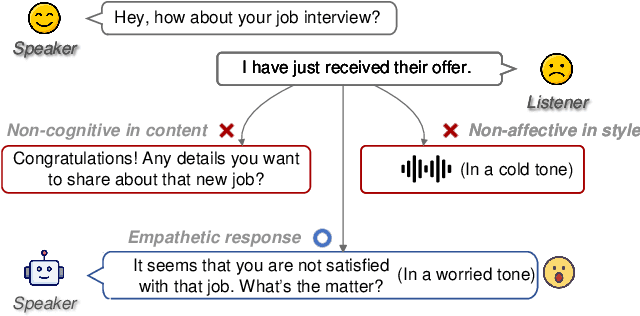
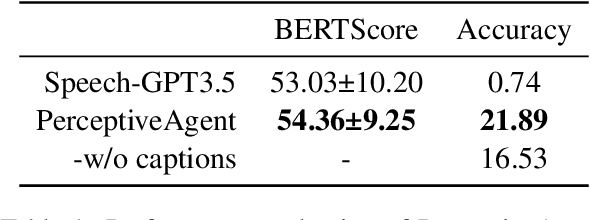
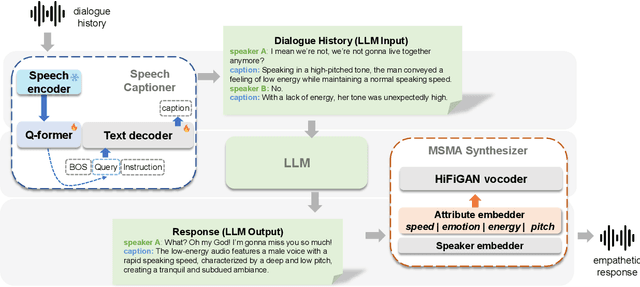

Abstract:Large Language Model (LLM)-enhanced agents become increasingly prevalent in Human-AI communication, offering vast potential from entertainment to professional domains. However, current multi-modal dialogue systems overlook the acoustic information present in speech, which is crucial for understanding human communication nuances. This oversight can lead to misinterpretations of speakers' intentions, resulting in inconsistent or even contradictory responses within dialogues. To bridge this gap, in this paper, we propose PerceptiveAgent, an empathetic multi-modal dialogue system designed to discern deeper or more subtle meanings beyond the literal interpretations of words through the integration of speech modality perception. Employing LLMs as a cognitive core, PerceptiveAgent perceives acoustic information from input speech and generates empathetic responses based on speaking styles described in natural language. Experimental results indicate that PerceptiveAgent excels in contextual understanding by accurately discerning the speakers' true intentions in scenarios where the linguistic meaning is either contrary to or inconsistent with the speaker's true feelings, producing more nuanced and expressive spoken dialogues. Code is publicly available at: \url{https://github.com/Haoqiu-Yan/PerceptiveAgent}.
HRVDA: High-Resolution Visual Document Assistant
Apr 10, 2024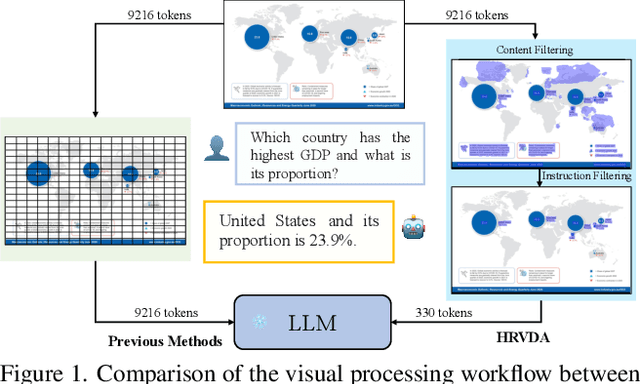
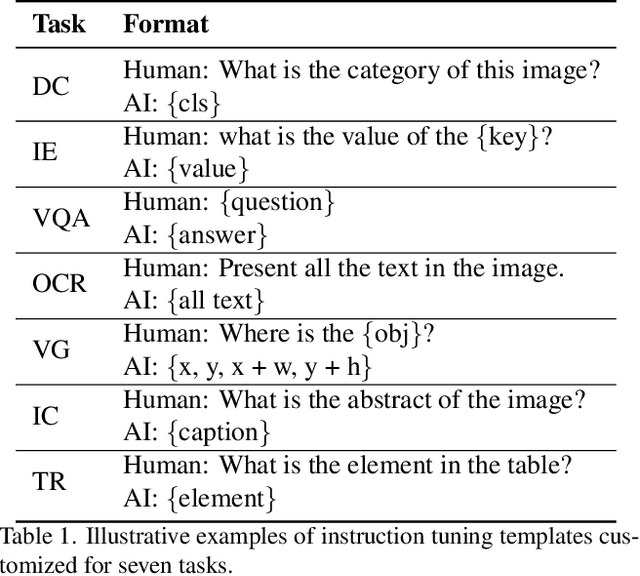
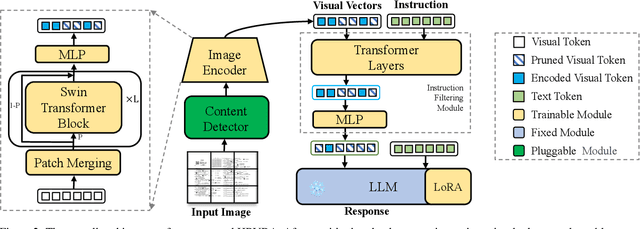

Abstract:Leveraging vast training data, multimodal large language models (MLLMs) have demonstrated formidable general visual comprehension capabilities and achieved remarkable performance across various tasks. However, their performance in visual document understanding still leaves much room for improvement. This discrepancy is primarily attributed to the fact that visual document understanding is a fine-grained prediction task. In natural scenes, MLLMs typically use low-resolution images, leading to a substantial loss of visual information. Furthermore, general-purpose MLLMs do not excel in handling document-oriented instructions. In this paper, we propose a High-Resolution Visual Document Assistant (HRVDA), which bridges the gap between MLLMs and visual document understanding. This model employs a content filtering mechanism and an instruction filtering module to separately filter out the content-agnostic visual tokens and instruction-agnostic visual tokens, thereby achieving efficient model training and inference for high-resolution images. In addition, we construct a document-oriented visual instruction tuning dataset and apply a multi-stage training strategy to enhance the model's document modeling capabilities. Extensive experiments demonstrate that our model achieves state-of-the-art performance across multiple document understanding datasets, while maintaining training efficiency and inference speed comparable to low-resolution models.
Enhancing Visual Document Understanding with Contrastive Learning in Large Visual-Language Models
Feb 29, 2024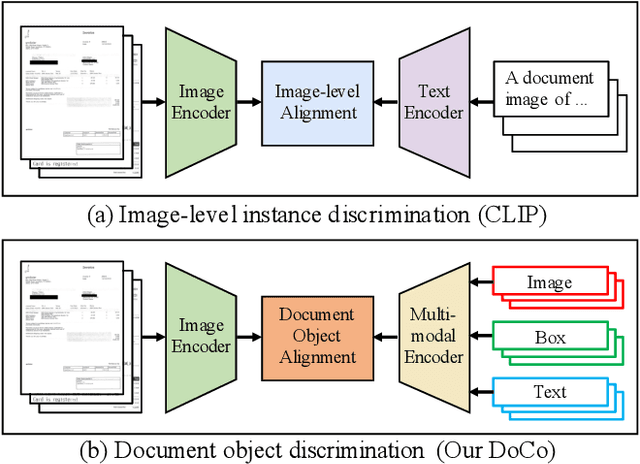
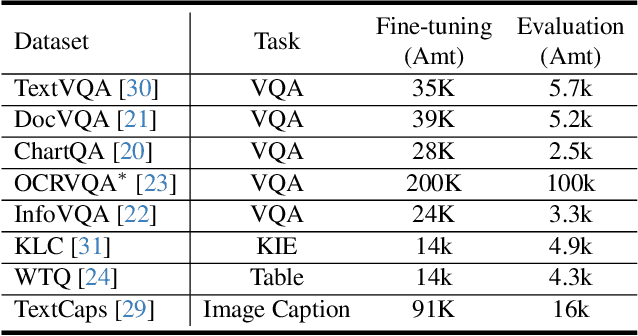
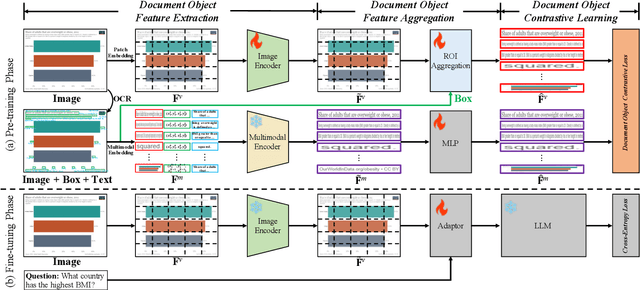

Abstract:Recently, the advent of Large Visual-Language Models (LVLMs) has received increasing attention across various domains, particularly in the field of visual document understanding (VDU). Different from conventional vision-language tasks, VDU is specifically concerned with text-rich scenarios containing abundant document elements. Nevertheless, the importance of fine-grained features remains largely unexplored within the community of LVLMs, leading to suboptimal performance in text-rich scenarios. In this paper, we abbreviate it as the fine-grained feature collapse issue. With the aim of filling this gap, we propose a contrastive learning framework, termed Document Object COntrastive learning (DoCo), specifically tailored for the downstream tasks of VDU. DoCo leverages an auxiliary multimodal encoder to obtain the features of document objects and align them to the visual features generated by the vision encoder of LVLM, which enhances visual representation in text-rich scenarios. It can represent that the contrastive learning between the visual holistic representations and the multimodal fine-grained features of document objects can assist the vision encoder in acquiring more effective visual cues, thereby enhancing the comprehension of text-rich documents in LVLMs. We also demonstrate that the proposed DoCo serves as a plug-and-play pre-training method, which can be employed in the pre-training of various LVLMs without inducing any increase in computational complexity during the inference process. Extensive experimental results on multiple benchmarks of VDU reveal that LVLMs equipped with our proposed DoCo can achieve superior performance and mitigate the gap between VDU and generic vision-language tasks.
 Add to Chrome
Add to Chrome Add to Firefox
Add to Firefox Add to Edge
Add to Edge